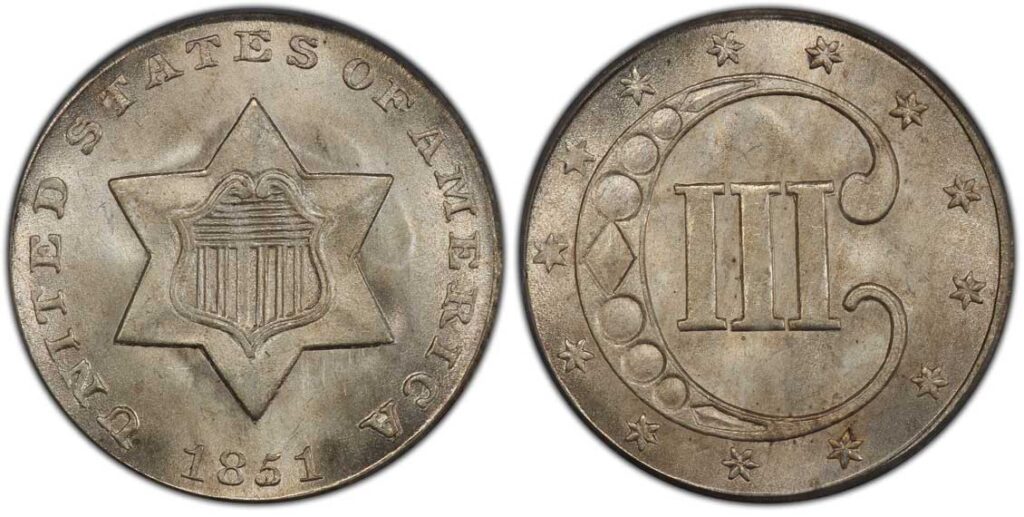The 3 cent nickel, also known as the three-cent piece or the trime, is one of the most obscure and short-lived coins in the history of the United States. It was minted from 1865 to 1889, and it was the first U.S. coin to be made of copper-nickel alloy. But why was it created, and what makes it so rare and interesting? Let’s find out!
The Origins of the 3 Cent Nickel
The 3 cent nickel was born out of a crisis that affected the U.S. economy and society during the Civil War. Due to the uncertainty and instability caused by the war, people hoarded gold and silver coins, creating a severe shortage of small change in circulation. To remedy this situation, the U.S. government issued paper currency and fractional currency notes, which were small paper bills in denominations as low as 3 cents. However, these paper notes were unpopular, as they were easily damaged, counterfeited, and inflated. Moreover, they did not match the decimal system of coinage, which was based on multiples of 5 cents.
In 1864, the U.S. Mint introduced two new coins to replace the fractional currency notes: the bronze cent and the two-cent piece. These coins were made of a cheaper and more abundant metal than silver, and they circulated widely and successfully. This inspired the idea of creating a three-cent coin in the same metal, to provide a convenient coin for paying postage, which had been reduced from 5 cents to 3 cents in 1851. The advocates of this idea were led by Joseph Wharton, a Pennsylvania industrialist who owned the largest nickel mine in the country and wanted to promote the use of nickel in coinage. Wharton lobbied Congress to pass a bill for a three-cent coin in copper-nickel alloy, which was approved on the last day of the congressional session, March 3, 1865, and signed by President Abraham Lincoln.
The Evolution of the 3 Cent Nickel
The 3 cent nickel was designed by James B. Longacre, the chief engraver of the U.S. Mint, and featured a portrait of Liberty on the obverse and a wreath surrounding a Roman numeral III on the reverse. The coin was made of 75% copper and 25% nickel, the same ratio used in today’s five-cent nickels. This composition has remained the same for all nickels with the exception of the silver alloy war nickels (from 1942-1945), regardless of denomination or series. The coin had a weight of 1.94 grams and a diameter of 17.9 millimeters, and it had a plain edge.
The 3 cent nickel was initially well received by the public, as it was more durable and convenient than the paper notes and the silver three-cent piece, which was still in production until 1873. The 3 cent nickel also had a higher silver value than its face value, which made it legal tender for unlimited amounts, unlike the silver three-cent piece, which was limited to $5. The 3 cent nickel reached its peak mintage in 1865, with over 11 million pieces struck. However, its popularity declined after 1866, when the U.S. Mint introduced the five-cent nickel, also known as the shield nickel, which was a larger and more attractive coin, and which matched the decimal system better than the 3 cent nickel. The five-cent nickel soon replaced the 3 cent nickel in circulation, and the demand for the latter coin dropped significantly. After 1870, most years saw very low mintages for the 3 cent nickel, and some years, such as 1877 and 1878, saw no circulation strikes at all, only proof coins for collectors. The 3 cent nickel was finally discontinued by the Coinage Act of 1890, which also abolished several other denominations, such as the half dime and the two-cent piece. The last 3 cent nickels were struck in 1889, and many of them were melted down to make more five-cent nickels.
The Legacy of the 3 Cent Nickel
The 3 cent nickel is a remarkable coin, as it reflects the economic and social changes that occurred in the U.S. during the Civil War era. It is also a rare and valuable coin, as it has a low mintage and a high survival rate. The coin’s value depends on several factors, such as the year, the condition, and the demand. The most common dates are 1865, 1866, and 1868 and the scarcest dates are 1877 and 1878, which were only minted as proof coins The coin has no mint marks, as all of them were struck at the Philadelphia Mint.

